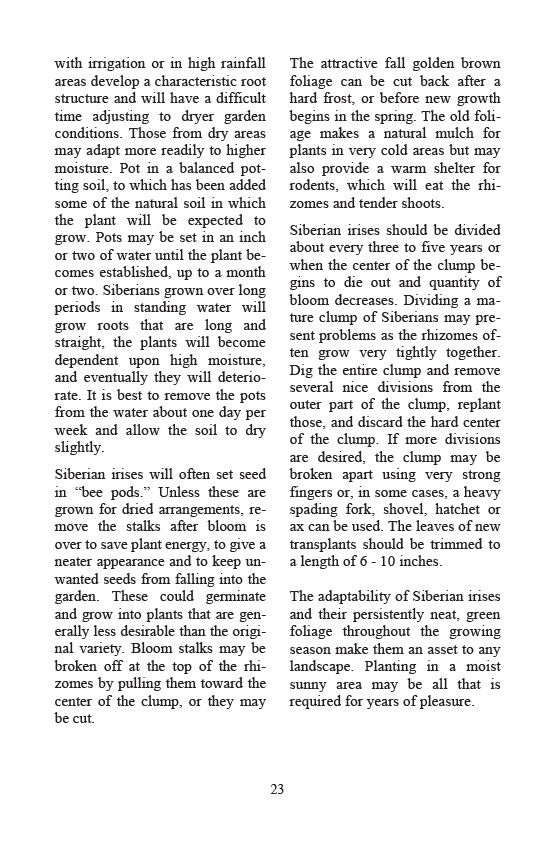
23
with irrigation or in high rainfall
areas develop a characteristic root
structure and will have a difficult
time adjusting to dryer garden
conditions. Those from dry areas
may adapt more readily to higher
moisture. Pot in a balanced pot-ting
soil, to which has been added
some of the natural soil in which
the plant will be expected to
grow. Pots may be set in an inch
or two of water until the plant be-comes
established, up to a month
or two. Siberians grown over long
periods in standing water will
grow roots that are long and
straight, the plants will become
dependent upon high moisture,
and eventually they will deterio-rate.
It is best to remove the pots
from the water about one day per
week and allow the soil to dry
slightly.
Siberian irises will often set seed
in “bee pods.” Unless these are
grown for dried arrangements, re-move
the stalks after bloom is
over to save plant energy, to give a
neater appearance and to keep un-wanted
seeds from falling into the
garden. These could germinate
and grow into plants that are gen-erally
less desirable than the origi-nal
variety. Bloom stalks may be
broken off at the top of the rhi-zomes
by pulling them toward the
center of the clump, or they may
be cut.
The attractive fall golden brown
foliage can be cut back after a
hard frost, or before new growth
begins in the spring. The old foli-age
makes a natural mulch for
plants in very cold areas but may
also provide a warm shelter for
rodents, which will eat the rhi-zomes
and tender shoots.
Siberian irises should be divided
about every three to five years or
when the center of the clump be-gins
to die out and quantity of
bloom decreases. Dividing a ma-ture
clump of Siberians may pre-sent
problems as the rhizomes of-ten
grow very tightly together.
Dig the entire clump and remove
several nice divisions from the
outer part of the clump, replant
those, and discard the hard center
of the clump. If more divisions
are desired, the clump may be
broken apart using very strong
fingers or, in some cases, a heavy
spading fork, shovel, hatchet or
ax can be used. The leaves of new
transplants should be trimmed to
a length of 6 - 10 inches.
The adaptability of Siberian irises
and their persistently neat, green
foliage throughout the growing
season make them an asset to any
landscape. Planting in a moist
sunny area may be all that is
required for years of pleasure.